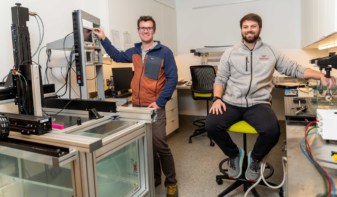
High-intensity focused ultrasound (HIFU) is an early-stage, non-invasive thermal therapy used to treat a variety of medical conditions, including neurological disorders and some cancers. Now, researchers at the City University of Hong Kong have developed an array-based HIFU system that integrates real-time ultrasound (US) and photoacoustic (PA) imaging to improve treatment delivery. The system provides temperature and structural information with which to guide therapy, overcoming previous challenges of long treatment times and inaccurate or costly image guidance.
HIFU offers the advantages of deep penetration, controllable ablation spot size and low hardware cost. A major disadvantage, however, is the often long treatment times, due to focal spots smaller than the actual dimension of the treatment region and fixed focus depths. Lengthy mechanical scanning may cause misalignment between the designated treatment spot and the actual HIFU focus. To minimize damage to surrounding healthy tissues, precise and timely dose control is critical.
Combining ultrasound imaging with HIFU can provide real-time monitoring at low cost, but has been inappropriate for clinical use due to insufficient temperature sensitivity to accurately guide the HIFU treatment. The new system, developed by Yachao Zhang and Lidai Wang and described in Biomedical Optics Express, resolves many issues by connecting the PA/US imaging transducer and the HIFU transducer to a single data acquisition system and programming the PA/US imaging and HIFU transmission synchronously.
The array-based HIFU transducer has a wide dynamic steering range in both the axial (40 mm) and lateral (16 mm) directions. Treatment spots are moved electronically by adjusting the excitation phase map, making it feasible to treat multiple spots relatively fast, at 15 s/spot. Zhang and Wang advise that because the multi-element HIFU transducer can also be used to acquire ultrasound images and align with the imaging transducer in the axial direction, the tedious spatial calibration process between therapeutic and diagnostic transducers can be avoided. The HIFU applicator selects the ablation region automatically, based on feedback from the dual-mode images.
The novel HIFU/PA/US system consists of four major components. A HIFU/imaging probe integrates a 128-channel HIFU transducer and a linear phased-array imaging transducer. The data acquisition system has 256 channels, half used for HIFU therapy and the other half for PA/US imaging. The setup also includes an optical system, comprising a tunable optical parametric oscillator laser and a Q-switched Nd: YAG laser. Finally, the control unit includes a motion controller to translate the sample, and a sequence controller to synchronize the HIFU transmission, the PA and US imaging, and the PA-based temperature monitoring.
To demonstrate dynamic multi-spot ablation using the HIFU transducer, the researchers designed a circular ablation pattern with nine target spots and used it to ablate a polydimethylsiloxane (PDMS) phantom. Using the position information, the HIFU system automatically ablated each spot for 15 s. The ablation pattern on the PDMS sample matched well with the planned design.

Focused ultrasound controls prostate cancer with fewer side effects
The researchers also tested the system using fresh chicken breast tissue. They used sequential HIFU transmission, PA imaging, PA thermometry and US imaging to display dual-mode images and record temperature changes of the target spot, verifying that the system can monitor HIFU therapy progress in real time. The experiments validated the precise and dynamic steering capability of HIFU ablation, and demonstrated that structural and functional information generated by co-registered dual images can precisely position the HIFU therapy and maintain dose control.
“Because of the advantages of multi-modal imaging and non-invasive therapy, the tri-modal system still shows great prospects in clinical application,” Zhang and Wang conclude.



